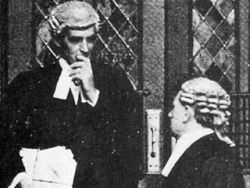 Reporting on the latest DYI enthusiast headed for the English High Court, a New York newspaper describes – without irony – the legalise euthanasia bid as ‘arguably a long shot’. More close call, or perhaps even parting shot, it seems to Dr No: but then we are two nations separated by a common language.
Reporting on the latest DYI enthusiast headed for the English High Court, a New York newspaper describes – without irony – the legalise euthanasia bid as ‘arguably a long shot’. More close call, or perhaps even parting shot, it seems to Dr No: but then we are two nations separated by a common language.
The case concerns a fifty-seven year old man who finds his life intolerable after a stroke seven years ago left him with the locked-in syndrome. An active capable and intelligent man before his stroke, he now sums up his life as ‘dull, miserable, demeaning, undignified and intolerable’, and, understandably, wants out. Being, he says, unable to do the deed himself, he has applied to the Court for a declaration that any doctor – in passing, Dr No does not see why the application has been limited to doctors – terminating his life will have a ‘common law defence of necessity’ against any possible murder charge.
Dr No is not entirely persuaded that the man is incapable of taking his own life. He is said to have some head movement – which suggests he might be able to head-butt a switch to trigger a contraption rigged up to deliver the fatal dose; or failing that, he is able to use a computer, and it cannot be beyond the wit of man to devise an ‘exit programme’ that would achieve, as the ID would say, the same ‘result’. In these scenarios, although assisted, the death would be one of suicide, in that the act which triggered death would be done by the individual. And suicide is not illegal. The legal obstacles would be reduced to those of assisting suicide; there would be no need for a pre-emptive declaration to safeguard Dr Death.
Be that as it may, the case does raise a difficult question about the current ‘you can be killed anyway you want so long as it is suicide’ state of the law. Consider, for a moment, twin brothers, in their fifties, and both, on the very same day, suffer strokes, and are left with the locked-in syndrome. Before their strokes, both were active capable and intelligent men, and both, following their strokes, retain their intelligence and sensibility, and both find their life intolerable, and, after due consideration, want out. So far, their circumstances are identical, but there is one crucial difference. The first twin does indeed have the full locked-in syndrome, but the second, against all the odds, has regained the movement of his left thumb. Then place the twins at Dignitas, where assisted suicide is allowed. The second twin is able, by initiating the last act that will lead to death, to commit suicide; but the first cannot.
This, it seems to Dr No, is a very thorny question. It cannot be solved by insisting that the twin with the working thumb desist – for he is of sound mind and settled intent, and has every right to determine his own fate. But, at the same time, it seems intolerable that an accident of motor function should deprive the dud thumb twin, who in our example is in every other respect truly and fully identical to his twin, of the same right to determine his own fate.
Long shot or not, it is indeed a very close call. Dr No cannot for the life of him see what the answer might be.
